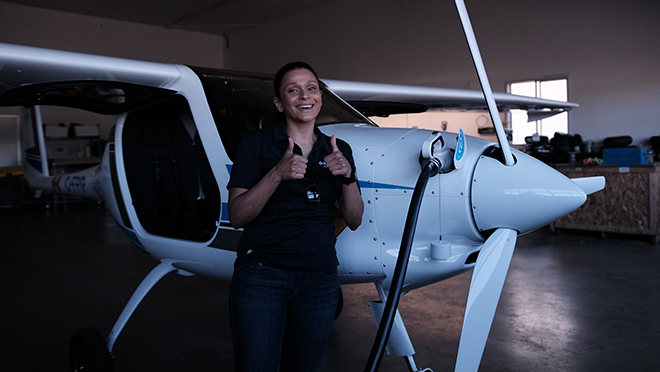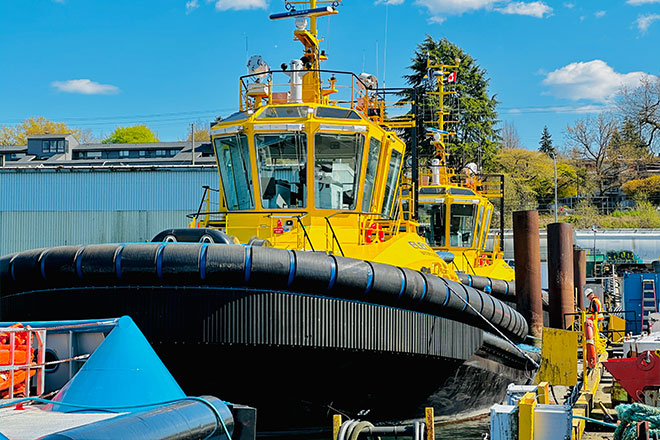It's a bird, it's a plane, it's... electric

B.C.'s Sealand Flight first in Canada to use electric plane for flight training
Part of a series on BC Hydro Clean Energy Champions: businesses, homes, and institutions – large and small – recognized for reducing their reliance on fossil fuels.
When Mike Andrews finally got to fly his first electric plane, he quickly understood how the design of the Pipistrel Velis Electro had as much in common with a glider as with an internal combustion-powered plane.
And while that first flight was remarkable, it was how it ended that impressed him the most.
"When you bring the power back for the landing and approach the runway, it just wants to keep flying," says Andrews, a flight instructor with Sealand Flight in Campbell River. "It’s one of the main differences in training – how to get the plane from flying to landing. It's a much different transition, because the airplane is designed so efficiently it doesn't need much power to stay in the air."
The Slovenian company Pipistrel has been shaking up the flight industry with innovative gliders, motorgliders, ultralights, and airplane designs for decades, and has a dandy origin story around its name. The company was famously forced to fly its first aircraft at night in the late 1980s because of then Yugoslavian regulations against flights by experimental aircraft. Triangular with hang-glider style wings, the aircraft's shape and night flights earned it the nickname "pipistrello", or "bat" in Italian.
Today, there's nothing stealthy or secret about Pipestrel's planes, other than the fact that – like an electric car – they are far quieter than their fossil fuel-powered cousins. The Pipistrel Velis Electro is in use at flight schools across Europe, and after being shipped to Campbell River in pieces in a box, it's now flying the skies above Vancouver Island using clean and renewable electricity.
"It's a tangible and viable way to start reducing aviation emissions," says Sealand's Andrews. "We're not expecting to save the planet with this one airplane, but it's a first step. And so we're looking to open the door to create the possibility for more widespread use in the future."
Sealand gets green light from Transport Canada for flight training
Earlier this year, Transport Canada gave Sealand clearance to have licensed pilots fly the two-seat electric plane. They soon got Transport Canada clearance to start flight training and began with a June 14 introductory flight for a newbie ("zero time") student, marking a Canadian first on an electric plane.
Since then, the flight school has been using the Pipistrel Velis Electro to teach several new students from the introductory stage to the solo stage of flight training. From there, the students will transition to classical internal combustion engine aircraft for the remainder of their training.
"Transport Canada wants it to be as safe, or safer, than the planes that we're currently using, and that's kind of the bottom line," says Ian Lamont, Sealand's chief flight instructor. "In Europe, there are people who have done their entire license training on this airplane."
BC Hydro provided funding for a study to help Sealand Flight understand the infrastructure required for charging electric aircraft. Initially, Sealand is charging the Pipistrel Velis Electro at their Campbell River Airport headquarters, and they plan to add charging capability at their three other locations at Powell River, Courtenay, and Qualicum Beach. With flight training sessions of about 50 minutes, Sealand expects the plane can operate on a 1-to-1 flight vs. charge time ratio.
Sealand Flight manager Nancy Marshall envisions a day when she can replace the aging Cessnas in Sealand's fleet with emissions-free, modern and lower maintenance electric planes.
"I would like to replace all of them with electric, and if you've ever driven a vehicle from the 1950s or 1960s, you'll know why," says Marshall, with a laugh.

Electrification of flight is a weighty challenge
While transportation represents about a fifth of global greenhouse gas emissions, air travel accounts for only about 11% of that chunk. And compared to cars and other ground transport, it's much harder to electrify aircraft. Batteries are heavy, and efficient flying is all about minimizing weight.
That hasn't stopped the likes of Pipistrel and Sealand Flight from trying to reduce flight-related CO2 emissions. And they're not alone. Air Canada is buying 30 electric-hybrid planes and plans to use them for shorter regional flights in 2028. B.C.'s Helijet has also ordered an electric vertical takeoff and landing helicopter, and Harbour Air plans to start using electric seaplanes between Vancouver and Vancouver Island as early as 2025.
Sealand Flight chose the Pipistrel Velis Electro because it's an ultralight plane – weighing in at about 600 kilos including a pair of 90-kg battery packs, one in front, one in back – specifically designed for flight training. And they did their homework, including taking a test flight, before making the purchase. Chief flight instructor Lamont went to Italy for that test and found that, other than how quiet it was, flying the Electro is not that different from flying the Cessna 172s that Sealand uses for flight training. Except for one major difference.
"I've flown gliders, and the kind of noise in the glider – just the wind noise of going 100 miles an hour – is similar to what you hear in the electric plane," says Lamont.
One big plus, according to Lamont, is that an electric power plane isn't affected by altitude the way an internal combustion plane is. With a fossil fuel-powered plane, pilots need to use a mixture control knob to manually adjust the fuel-to-air ratio as the plane climbs.
"Anybody who drives a car with a carburetor knows that when they go into the mountains, they have to adjust the carburetor because the air gets thinner," says Lamont. "In planes like our Cessna 172, we actually lose a little bit of power as we climb to a higher altitude. With the electric airplane, I didn't lose any power, or very minimal power, at altitude."
Another big difference is the flight controls in the cockpit. The Cessnas are a 1960s-era technology, while the Electro's digital feedback provides data ranging from temperature, speed, power consumption and altitude to specifics around battery health. Everything is recorded, and later downloaded so that Sealand can monitor the plane’s performance data for each flight.
"This data should further our understanding of power consumption in different phases of flight and during different tasks," says Sealand pilot Andrews. "And it can help us understand how weather affects us."
Andrews says Ontario's Waterloo Institute for Sustainable Aeronautics is also examining the Electro with in-depth studies that include a look at how extreme cold affects the plane's performance. Their work with the plane is also key in helping Transport Canada provide the go-ahead for flight training with the Electro.

A quieter plane should be embraced by communities near flight training
Andrews says there are examples around the world where flight training has been shut down or limited after noise complaints in communities near airports. The Pipistrel Velis Electro has grown in popularity in Europe in part because of how much quieter it is than internal combustion planes.
What does it sound like? Andrews says propeller noise is audible, but that a person standing outside at an airport as an Electro takes off will hear only a "turbine-type noise" akin to a plane flying overhead at 10,000 to 12,000 feet. And inside the cockpit, it's a whole different experience for a pilot.
"It's a little bit noisy on takeoff and as you climb up, but once you're cruising, you hardly even need a headset," he says. "It's quite quiet and peaceful, knowing that it's all electric. It's like driving an electric vehicle: that satisfactory feeling where you don't feel the engine kind of working away with a whole bunch of mechanical and combustion processes."
Or carbon emissions.







